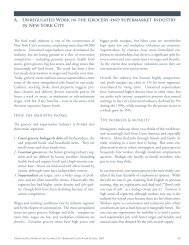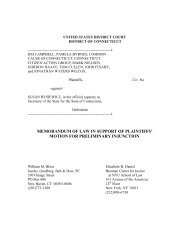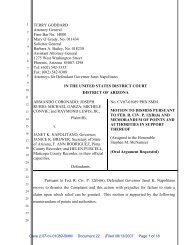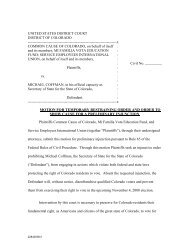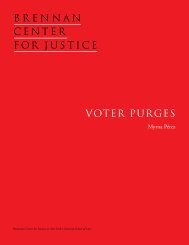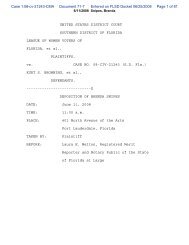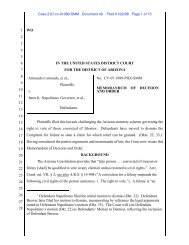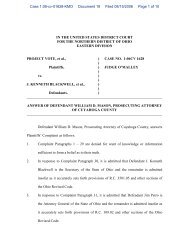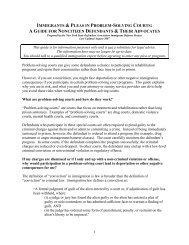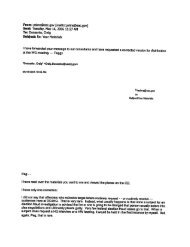Thousands of fair use cases have been decidedsince Congress listed the four factors in the 1976Copyright Act. In 1980, a court found a SaturdayNight Live parody of the jingle “I Love NewYork” in a comedy sketch called “I Love Sodom”to be fair use. 22 There was a similarly favorableruling six years later for a parody of the song“When Sonny Gets Blue,” called “When SonnySniffs Glue.” 23 But an appeals court in 1997reversed a finding of fair use where a TV stationused a poster depicting a quilt by the artist FaithRinggold as part of a set decoration, and sent thecase back for more factfinding on the first andfourth factors. 24 The artist Jeff Koons lost on hisfair use defense when he copied a commercialphotograph called “Puppies” in the course ofcreating a three-dimensional sculpture, because,the court said, his sculpture was a “satiricalcritique of our materialistic society,” ratherthan a specific parody of the “Puppies” photo. 25And although a court in 1973 approved thephotocopying of journal articles by governmentlibraries for the purpose of advancing scientificresearch, this fair use-friendly approach wasnot extended to research scientists’ copying ofarticles at a private company. 26Practices That Threaten FreeExpression and Fair UseTaking advantage of fair use has always beendifficult because of its unpredictability, the highcost of defending it in court, and the crushingliability that may result if one guesses wrong. Buttoday, there are additional factors that create evenmore serious threats to free expression and fair use.Cease and Desist LettersThe first of these is the widespread practiceamong IP owners of sending “cease and desist”letters to threaten everyone from artists andsocial critics to commercial competitors withdire punishments for copyright or trademarkinfringement. The practice is not new, but theaggressiveness and volume of cease and desistletters has increased with the coming of theInternet, where copying is more visible andreaches larger audiences than in the past. Insome cases, the recipients of cease and desistletters would qualify for the fair use defense, orFirst Amendment protection under trademarklaw. The letters, needless to say, do not mentionthese possibilities.In the mid-1990s, for example, the RepublicanNational Committee sent a cease and desistletter to a pair of artists who expressed theiropinion of the party’s “Contract With America”by reproducing its text on a limited edition setof underpants. A reply letter from a New Yorklaw firm, defending the artists’ fair use andFirst Amendment rights, ended that dispute. 27But this did not dissuade the Office of VicePresident Dick Cheney in 2002 from sending aletter to Chickenhead Productions, complainingabout a parody biography of Cheney’s wifeLynne along with photos on Chickenhead’swhitehouse.org satire site. 28 The tenor of theCheney page could be gleaned from its heading:“The Bush Administration: Courage. Passion.Faith. Petroleum. Xenophobia.” 29 In response tothe letter, the site adorned the photos of Mrs.Cheney with a red clown nose and labels reading“Censored.” The New York Civil Liberties Unionannounced that it would go to court if necessaryto defend Chickenhead. 30In these extreme examples, the recipients ofcease and desist letters were not intimidated.But as our research showed, threats of litigationcarrying potentially massive costs do cause manypeople to relinquish their rights. 31 If the IPowner sues, even a weak copyright or trademarkclaim can cost a defendant many thousands(potentially hundreds of thousands) of dollars.The pressure to settle is intense. Thus, manyrecipients compromise their rights in order toend the controversy before huge costs ensue, andoften before any lawsuit is filed.DMCA Take-Down NoticesThe Digital Millennium Copyright Act or“DMCA,” passed by Congress in 1998, is a farreachinglaw that controls the public’s ability toaccess and copy materials in digital form. Section512 of the law provides a “safe harbor” frompossible copyright liability for Internet serviceproviders (ISPs) – including search engines– that “expeditiously” remove any material ontheir servers that a copyright owner tells them in“good faith” is infringing. No legal proceedingsare needed. 324 Will Fair Use Survive?
Although §512 does allow an ISP “subscriber”to send a counter-notice contesting the allegationof infringement, the requirements of the counternoticeare detailed and technical, and not everyWeb speaker is a “subscriber” who can makeuse of the procedure. 33 Those contributing toongoing discussions in newsgroups, for example,may not even be aware that their words, images,or links have been removed.Section 512 is misguided because ISPsshould not be liable for copyright infringementin the first place, simply because someone isusing their servers to infringe. ISPs are akin totelephone companies or highways: they providea means of transport. Wrongs committed byusers of telephones or drivers on highways arenot attributed to those providing the conduits.Section 512 ignores this principle in theinterests of helping copyright owners protecttheir rights, but it provides an insufficient checkon overreaching, and creates an unacceptableshortcut around the procedures that are neededto decide whether speech is actually infringing.Just as with cease and desist letters, so with§512 take-down notices, some of the targetedmaterial has a strong or at least reasonablelikelihood of being fair use. Yet copyrightholders can churn out take-down letters withlittle effort, and cause the suppression of speechthey don’t like without ever going to court.In one egregious example, Diebold, Inc., amanufacturer of voting machines, sent takedownletters to Swarthmore University andother ISPs demanding the removal of studentWeb postings containing internal emails ofDiebold employees that discussed defects in thecompany’s machines. The students sued; thecompany backed off; and the court ruled thatthe postings were fair use, noting: “It is hard toimagine a subject the discussion of which couldbe more in the public interest.” 34The “Clearance Culture”The notion that every quotation except themost minimal must be licensed and paid foris pervasive in the commercial world of artsand culture. Many publishers expect theirauthors to obtain permission for all quotes andillustrations. In the music industry, the practiceof requiring a license for even the smallest sampleis entrenched. 35 As the author and activist DavidBollier writes, the free borrowing that was criticalto rap music innovation, just as it was to blues andsoul music, soon became a threat to the clearanceculture, and performers began to pay for licenses,“largely to placate their record labels.” 36Filmmaking is where the clearance culture hasmost effectively eviscerated fair use. Researchersat American University have reported on theproblems of filmmakers in finding rightsholders,being forced by exorbitant license feesto drop valuable material, and being unable totake advantage of fair use because of the rigidrequirements of the “errors and omissions” (or“E&O”) insurance policies that are needed forcommercial distribution. 37 These policies requirepermission for every snippet of film, photographs,music, or text that is used, in addition to shotsof distinctive buildings or products. 38 The formmakes no mention of fair use.When we interviewed a leading broker,Dennis Reiff, about practices in the industry,he told us that a good attorney can occasionallynegotiate riders to E&O policies for fair use.This is difficult, though, if the film “might havean impact.” That is, if “it’s really controversialmaterial,” “if it’s really blasting something – likeinvestigative reporting – then that could be aproblem, because the person in question maynot want to be investigated. And they may wantto sue you to stop you from doing it. Which isthe most common form of censorship.”Reiff said that the terms of E&O policies havenot changed much in the past 30 years, but theinsurance itself was less prevalent then. “Rightnow you cannot put anything on the air withoutE&O insurance. There is no cable station,broadcast station, or distribution company thatwill release anything without E&O insurance.”Why the change? Reiff attributes it to twofactors. The first is the experience of mediacompanies with big defamation cases, such asthose brought in the 1980s against CBS byGeneral William Westmoreland, and against Timemagazine by former Israeli Defense Minister ArielSharon. 39 Even though these cases had nothing todo with copyright, E&O policies are a package,and if media companies decide to require themfor film distribution, then demands for copyrightclearance become part of the bargain.Brennan Center for Justice 5
- Page 1 and 2: WILLFAIR USESURVIVE?Free Expression
- Page 3 and 4: WILLFAIR USESURVIVE?Free Expression
- Page 5: ContentsExecutive Summary . . . . .
- Page 9: unhappy years of World War II.” 1
- Page 13 and 14: music, distance learning, interlibr
- Page 15 and 16: CHAPTER 1The Legal LandscapeThis ch
- Page 17 and 18: Court’s “Oh, Pretty Woman” de
- Page 19 and 20: the public would be confused about
- Page 21 and 22: CHAPTER 2Quoting Sartre, Using Prok
- Page 23 and 24: owned by Gallimard [the French publ
- Page 26 and 27: well, this and this person gave it
- Page 28 and 29: you can do with the pages of Time a
- Page 30 and 31: going to start writing letters for
- Page 32 and 33: causing problems for our communitie
- Page 34 and 35: or Not’ people. So we took it dow
- Page 36 and 37: The American Pool Players Associati
- Page 38 and 39: “Paris Hilton Sex Tape” 150 (ho
- Page 40 and 41: howardhallis.com,” a comedy and c
- Page 42 and 43: legitimate borrowing of protected m
- Page 44 and 45: Dan Hamilton, managing editor of th
- Page 46 and 47: legal action as long as eInfoworld
- Page 48 and 49: At that point, Cox took to the blog
- Page 50 and 51: her books, but not created by Anne
- Page 52 and 53: CHAPTER 5Internet Infidels and Home
- Page 54 and 55: she attributed to the many form let
- Page 56 and 57: “Without his permission, the gove
- Page 58 and 59: eproducing an artwork in a book wit
- Page 60 and 61:
ConclusionWhat can we learn from th
- Page 62 and 63:
Reiff thought that instead, the gov
- Page 64 and 65:
Endnotes1 Mattel v. Walking Mountai
- Page 66 and 67:
48 See Katie Dean, “Eyes on the P
- Page 68 and 69:
109 Not an exact quote. See Alan Al
- Page 70 and 71:
149 http://msophelia.blogspot.com/p
- Page 72 and 73:
215 “MBA Legal Defense Initiative
- Page 74 and 75:
lank left hand page
- Page 76:
161 Avenue of the Americas12 th Flo



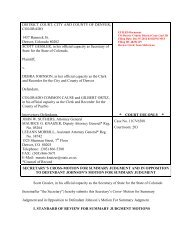
![Download the Letter [PDF] - Brennan Center for Justice](https://img.yumpu.com/50139248/1/190x245/download-the-letter-pdf-brennan-center-for-justice.jpg?quality=85)
